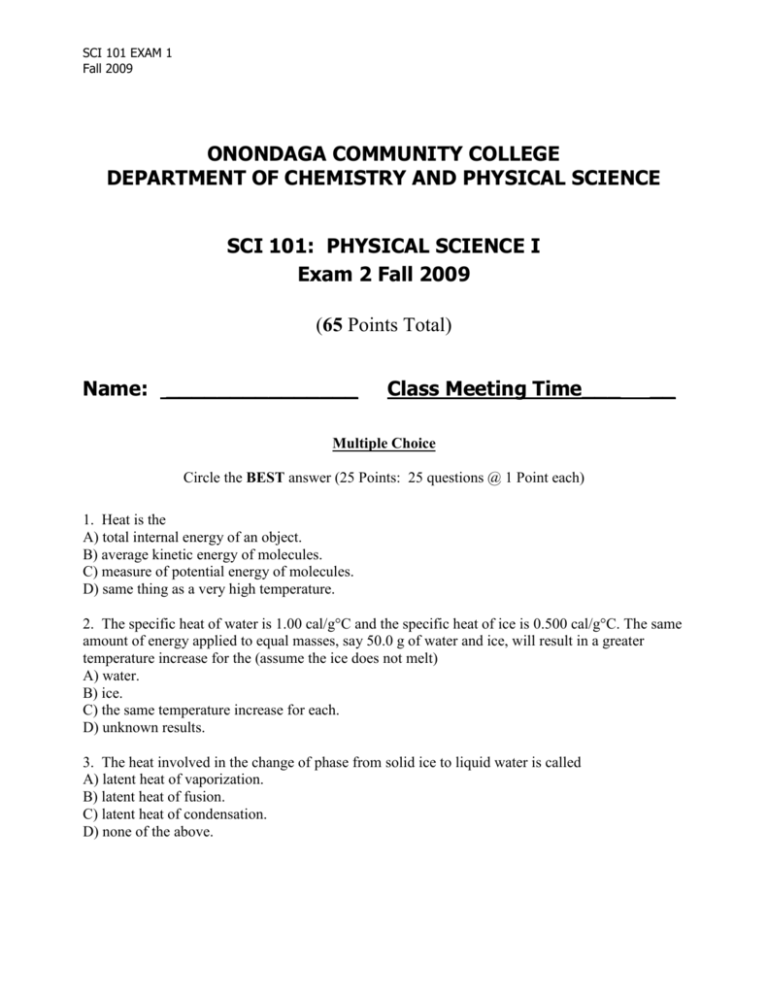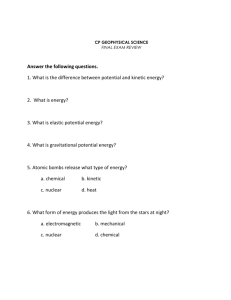sci 101: Physical sCIENCE i - Onondaga Community College
advertisement

SCI 101 EXAM 1 Fall 2009 ONONDAGA COMMUNITY COLLEGE DEPARTMENT OF CHEMISTRY AND PHYSICAL SCIENCE SCI 101: PHYSICAL SCIENCE I Exam 2 Fall 2009 (65 Points Total) Name: _______________ Class Meeting Time___ __ Multiple Choice Circle the BEST answer (25 Points: 25 questions @ 1 Point each) 1. Heat is the A) total internal energy of an object. B) average kinetic energy of molecules. C) measure of potential energy of molecules. D) same thing as a very high temperature. 2. The specific heat of water is 1.00 cal/g°C and the specific heat of ice is 0.500 cal/g°C. The same amount of energy applied to equal masses, say 50.0 g of water and ice, will result in a greater temperature increase for the (assume the ice does not melt) A) water. B) ice. C) the same temperature increase for each. D) unknown results. 3. The heat involved in the change of phase from solid ice to liquid water is called A) latent heat of vaporization. B) latent heat of fusion. C) latent heat of condensation. D) none of the above. SCI 101 EXAM 1 Fall 2009 4. The temperature of a gas is proportional to the A) average velocity of the gas molecules. B) internal potential energy of the gas. C) number of gas molecules in a sample. D) average kinetic energy of the gas molecules. 5. Latent heat is "hidden" because it A) goes into or comes out of internal potential energy. B) is a fluid (caloric) that cannot be sensed. C) does not actually exist. D) is a form of internal kinetic energy. 6. As a solid undergoes a phase change to a liquid, it A) releases heat while remaining a constant temperature. B) absorbs heat while remaining a constant temperature. C) releases heat as the temperature decreases. D) absorbs heat as the temperature increases. 7. When you add heat to a substance, its temperature A) always increases. B) sometimes decreases. C) might stay the same. D) might go up or down, depending on the temperature. 8. With all other factors being equal, the most likely to burn your mouth when taken directly from an oven is a food with A) higher specific heat. B) lower specific heat. C) specific heat is not important in this situation. D) more information needed. 9. A large and a small container of water with the same temperature have A) the same total amounts of internal energy. B) the same amounts of internal and external energy. C) different amounts of heat. D) the same amounts of all forms of energy. 10. A back and forth motion that repeats itself is a A) spring. B) vibration. C) wave. D) pulse. SCI 101 EXAM 1 Fall 2009 11. The maximum displacement from rest to the crest or from rest to the trough of a wave is called A) wavelength. B) period. C) equilibrium position. D) amplitude. 12. A wave with motion perpendicular to the direction that the wave is moving is classified as a A) longitudinal wave. B) transverse wave. C) water wave. D) compression wave. 13. Sound waves with frequencies greater than 20,000 Hz are A) infrasonic waves. B) supersonic waves. C) ultrasonic waves. D) impossible. 14. Generally, sounds travel faster in A) solids. B) liquids. C) gases. D) vacuums. 15. Two sound waves of equal amplitude with slightly different frequencies will result in A) an echo. B) the Doppler effect. C) alternation of loudness of sound known as beats. D) two separate sounds. 16. Longitudinal mechanical waves will move only through A) solids. B) liquids. C) gases. D) All of the above are correct. 17. What comment is true about the statement that "the human ear hears sounds originating from vibrating objects with a frequency between 20 and 20,000 Hz"? A) This is true only at room temperature. B) About 95 percent hear in this range, while some hear outside the average limits. C) This varies, with females hearing frequencies above 20,000 Hz. D) Very few people hear this whole range, which decreases with age. SCI 101 EXAM 1 Fall 2009 18. What is changed by destructive interference of a sound wave? A) frequency B) phase C) amplitude D) wavelength 19. An airplane pilot hears a slow beat from the two engines of his plane. He increases the speed of the right engine and now hears a slower beat. What should the pilot now do to eliminate the beat? A) Increase the speed of the left engine B) Decrease the speed of the right engine C) Increase the speed of both engines D) Increase the speed of the right engine 20. Resonance occurs when an external force matches the A) interference frequency. B) decibel frequency. C) beat frequency. D) natural frequency. D) standing waves. 21. The time required for one cycle of any repeating event is called one A) hertz. B) period. C) frequency. D) amplitude. 22. A transverse wave causes particles of a material to move A) back and forth in the same direction the wave is moving. B) perpendicular to the direction the wave is moving. C) in a circular motion in the direction the wave is moving. D) in a circular motion opposite the direction the wave is moving. 23. You hear a higher pitch when a sound wave has a greater A) amplitude. B) velocity. C) frequency. D) wavelength. 24. The extent of displacement of a vibrating tuning fork is related to the resulting sound wave characteristic of A) frequency. B) amplitude. C) wavelength. D) period. SCI 101 EXAM 1 Fall 2009 25. During a track and field meet, the time difference between seeing the smoke from a starter's gun and hearing the "bang" would be less A) on a warmer day. B) on a cooler day. C) if a more powerful shell is used. D) if a less powerful shell is used. Short Answer Questions (4 points each awarded based on completeness) The kinetic theory of matter is a very successful theory because it successfully explains phenomena in several different fields of physics. Answer the questions below in a few sentences using the principles of the kinetic theory of matter and your knowledge of Heat and Waves Be certain to refer to principles of the kinetic theory of matter in each of your answers. 1) Sound waves travel more slowly in colder air than in warmer air. Why is this so? 2) The speed of sound in hydrogen gas is about four times faster than the speed of sound in air at the same temperature. Why is this so? SCI 101 EXAM 1 Fall 2009 3) Steel has a speed of sound that is about three times faster that the speed of sound in lead. Why is that? 4) When you stick your hand into a 450 F oven to remove a baking pan of food. The 450 F air in the oven does not burn your hand or ignite your sleeve or oven mitt. Why is this so? 5) Heat continues to enter a boiling pot of water but it’s temperature does not change. Why is this so? SCI 101 EXAM 1 Fall 2009 Problems (20 Points) TO GET FULL CREDIT, YOU MUST SHOW ALL WORK INCLUDING VARIABLES, EQUATIONS USED, UNITS, AND CONVERSIONS 1) A steel bar has a sound wave traveling through it with a frequency of 15,000 Hz. What is the wavelength of that sound wave in the steel? (4 points) 2) 100 grams of room temperature water (T=20C ) is placed into a freezer that will lower the temperature of the water to -10 C. How much heat must be removed by the freezer? (6 points) SCI 101 EXAM 1 Fall 2009 3) A warm summer afternoon (T=32 C) thunderstorm produces lightning that you see 3 seconds before you hear the associated thunder clap. How far away is the thunderstorm? (4 points) This problem will ask you to apply the concepts of energy and heat to explore, very simply, the consequences of a large asteroid impact on the Earth’s oceans. All the parameters that are given below are realistic values. 4) An asteroid moving at 15 km/s has a diameter of 100 kilometers and a mass of 1.26x1019 kg. The asteroid impacts the Earth in the ocean. Assume that all the kinetic energy of the asteroid goes into heating all the Earth’s ocean water (this assumption is not that realistic but it provides an easy starting point for the problem.). The volume of Earth’s oceans is about 2.55x1018 m3 and the mass of the Earth’s oceans is about 3.19x1021 kg A) Calculate the kinetic energy of the asteroid. (It will be a very large number). Express this energy in kcal. (3 points) B) Using the specific heat of seawater, calculate the temperature increase of the Earth’s oceans from their current average temperature of 4C , assuming all the KE went into heating the ocean water.(3 points) Answer on the bottom of the next page. SCI 101 EXAM 1 Fall 2009








